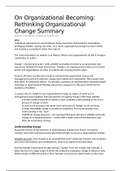Samenvatting
Summary On Organizational Becoming: Rethinking Organizational Change. Haridimos Tsoukas & Robert Chia
- Instelling
- Radboud Universiteit Nijmegen (RU)
Summary of the paper by Haridimos Tskouas & Robert Chia with the topic: On Organizational Becoming: Rethinking Organizational Change. For the course Organizational Change in the school year 2020/2021.
[Meer zien]




